Did you know you can use your investment dollars to advocate for climate change solutions?…
The post How To Invest For A Healthy Planet appeared first on Earth911.

Did you know you can use your investment dollars to advocate for climate change solutions?…
The post How To Invest For A Healthy Planet appeared first on Earth911.
2023 was a challenging year for environmental, social, and governance (ESG) investing, even though more…
The post Earth911 Podcast: Ben Vivari On Getting Started With ESG Investing appeared first on Earth911.
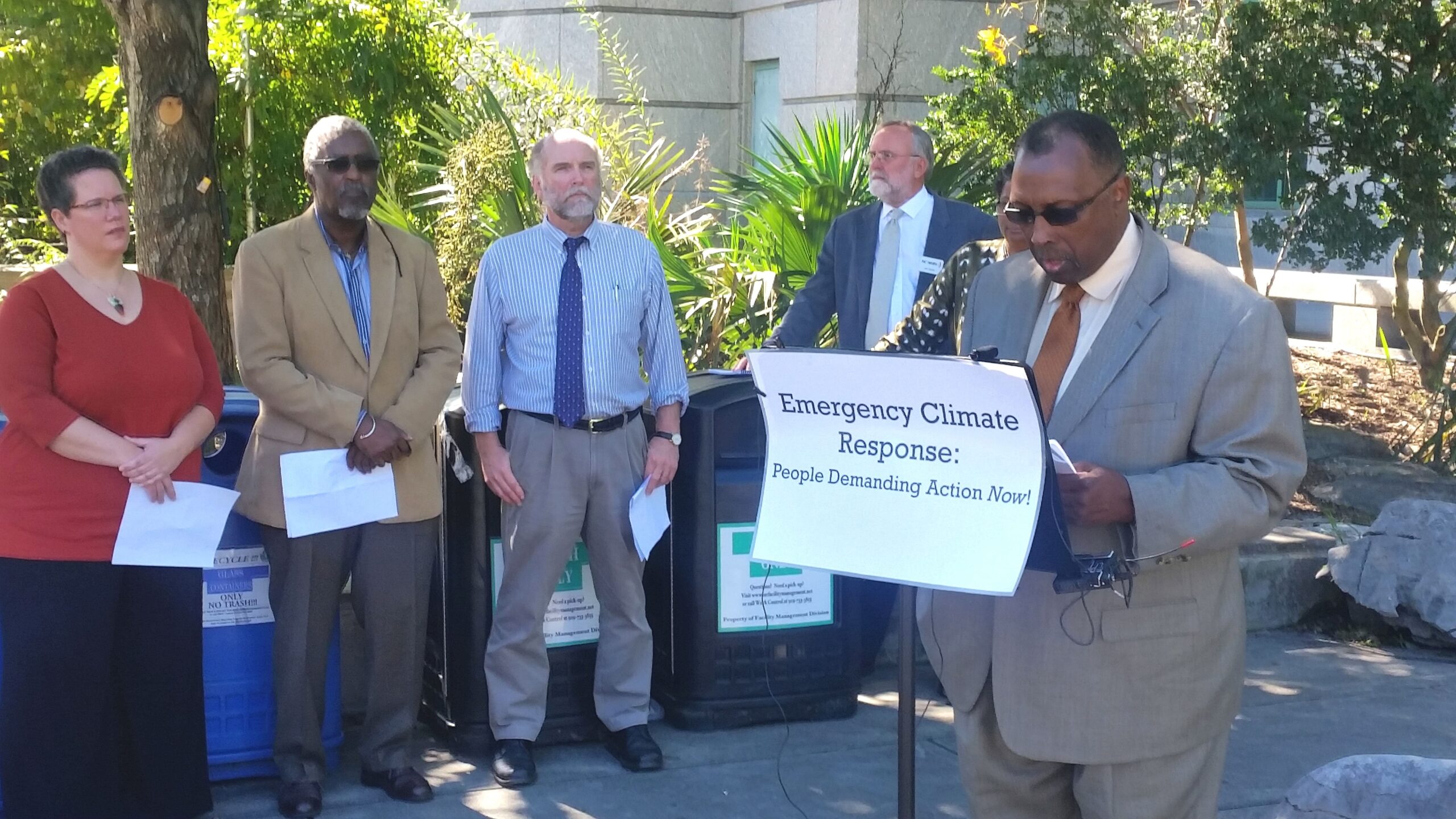
This story was originally published by Floodlight, a nonprofit newsroom that investigates the powerful interests stalling climate action, and Capital B, a nonprofit news organization that centers Black voices, audience needs and experiences, and partners with the communities it serves.
Former Florida state Rep. Joe Gibbons sat in the library of the Faith Community Church in Greensboro, North Carolina, trying to convince its pastor to quit promoting rooftop solar.
With a lobbyist’s charm, Gibbons told the Rev. Nelson Johnson that rooftop solar, which allows customers to generate their own renewable electricity, was bad for people of color. Gibbons argued that it creates an imbalance in which those without solar panels end up subsidizing those who have them, Johnson recalled in an interview with Floodlight.
Johnson, a civil rights stalwart who was stabbed by a member of the Ku Klux Klan in 1979, had trouble believing him.
“It felt like he was an employee of Duke,” Johnson said of Gibbons, referencing his state’s power company. Johnson rejected the overture.
At the time Gibbons met Johnson in 2015, Duke Energy was opposing a state bill that would have allowed anyone to install solar panels and sell electricity directly to consumers. Johnson was at the center of a legal battle over just such a third-party solar project planned for his church.
Gibbons wasn’t a Duke employee — not directly anyway. He founded a tax-exempt group called the Energy Equity Alliance; little information about its finances are available. But it was closely aligned — through two board members and Gibbons’ wife, Ava Parker — with NetCommunications, a Black-owned consulting firm. That year, NetCommunications was paid $750,000 by the Edison Electric Institute (EEI), a powerful utility trade group to which Duke belongs, for “consulting.” Duke did not respond to requests for comment.
Gibbons denied receiving funding from any utility in an interview with Floodlight and Capital B. But tax records and leaked internal documents confirm that a separate tax-exempt group he founded in 2018 received $2.8 million from a network of tax-exempt groups controlled by power company consultants. He later declined to answer specific questions about his industry ties.
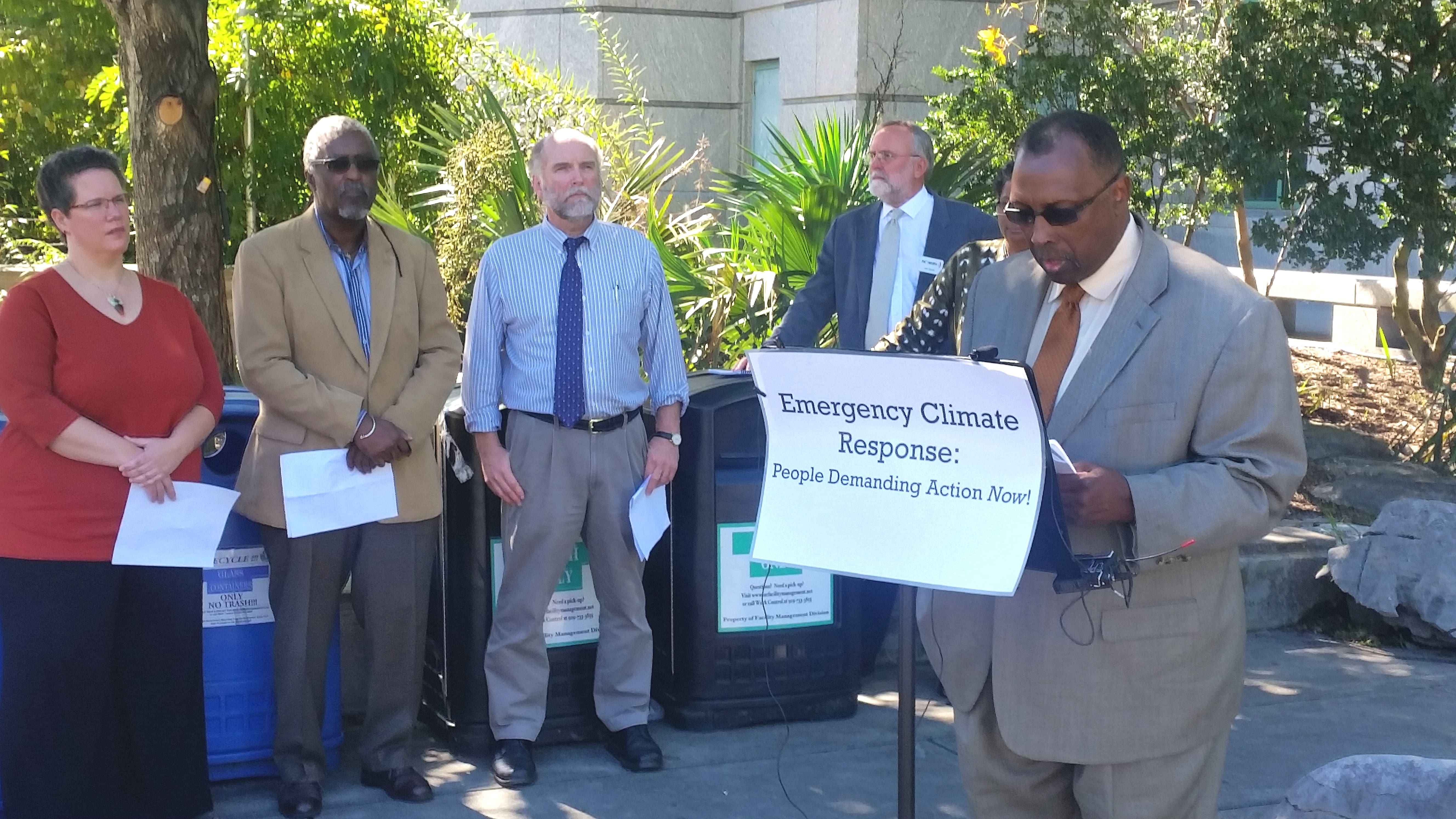
Johnson wasn’t the only Black leader Gibbons pitched, according to recordings of his public statements. More than two dozen Black civil rights leaders in the Southeast have been high-value targets in power companies’ battle for market dominance, courted and at times even co-opted by the industry, according to an investigation by Floodlight and Capital B.
The multibillion-dollar power companies use Black support to divert attention from the environmental harms that spew from their fossil fuel plants, the investigation found, harms which disproportionately fall on Black communities. One civil rights leader received power company cash as he built support for its attempted takeover of a smaller municipal utility in Florida. Another fought state oversight in Alabama that could have lowered electric bills and federal oversight that could have restricted emissions and pollution from coal burning power plants.
Some civil rights and faith leaders “will sell you out because they’ll sell anything — they’ll sell sea water,” said the Rev. Michael Malcom, executive director of the environmental justice organization Alabama Interfaith Power & Light in Birmingham.
“But there are others who are earnest and trying to survive … and it causes them to make some bad decisions. And there is a whole ‘nother group that is just ignorant to the idea [of environmental justice] and will sell you out due to that ignorance.”
How valuable was this tie between Southern utility companies and civil rights groups? In 2018, Alabama Power was paying a contractor nearly $1.5 million a year to, among other things, “provide ongoing direct relations” with the Southern Christian Leadership Conference, a civil rights group founded by the Rev. Martin Luther King Jr., according to a leaked copy of the contract.
Gibbons’ 2015 conversation with Johnson was part of a broader campaign implemented by trade group EEI to slow technologies such as rooftop solar.
Edison Electric Institute spokesperson Brian Reil defended his organization’s actions, saying they are aimed at protecting low-income ratepayers.

“EEI has no issue with rooftop solar,” Reil said in a written statement. “EEI has an issue with poorly designed … policies that overcompensate private rooftop solar system owners at the expense of other customers.”
He cited a new study by the National Academy of Sciences which found that the price of electricity remains relatively stable when the adoption of rooftop solar panels is low — currently just 1 percent nationwide and below 5 percent in all but four states — but it may rise as participation rates grow.
Consultants working for the powerful industry trade group were behind the formation of Gibbons’ organization.
On a leaked 2014 EEI conference call, an employee of consulting firm NetCommunications teased a forthcoming report to be published by the Energy Equity Alliance, a tax-exempt group that appears to not have been incorporated yet. The group was formed a month later in Florida with Gibbons as its director. During his four years at its helm, Gibbons lobbied for restrictions on rooftop solar in South Carolina, rallied Black federal legislators against the technology, and traveled the country “educating” ministers and civil rights leaders about rooftop solar.
And in 2018, Gibbons was working with Floridians for Affordable Reliable Energy, the tax-exempt group that got $2.8 million from groups operated by Alabama-based power company consultants Matrix LLC. In that effort, Gibbons whipped up opposition among Florida civil rights groups to a ballot initiative that would have introduced competition into Florida’s monopoly energy markets.
Floridians for Affordable Reliable Energy filed a friend of the court brief with the Florida Supreme Court arguing the measure would “significantly increase electricity costs for seniors, low income households, minority communities, average citizens and small businesses in Florida.”
Several chapters of The Urban League, a civil rights group, also signed on with Gibbons. Richard Danford, the president of Jacksonville’s Urban League chapter, says Gibbons was instrumental in securing funding for the chapter when it was struggling in 2019. The court ultimately struck the amendment down, finding its language confusing.
In a terse interview, Gibbons confirmed he “did some energy stuff” and “got involved with different advocacy groups.” And he says he still stands by the utility-aligned policies he advocated.
The joint investigation found that since at least 2009, consulting companies have worked on behalf of major power companies seeking to influence Black leaders and their organizations. They worked primarily through 501(c) 4 organizations, tax-exempt groups that are allowed to engage in political activity.
Two of the nation’s largest power companies, NextEra Energy and Southern Company, employed Matrix LLC, whose tactics included secretly funneling money to news sites that attacked clean energy proponents, surveilling a journalist who wrote critically about FPL and employing a corporate operative posing as a reporter to rattle political opponents.

Matrix’s founder, Joe Perkins, has maintained that its former CEO, Jeff Pitts, was a “rogue employee” who performed much of the work without Perkins’ knowledge. In court filings, Pitts has alleged that his boss was aware and has accused Perkins of wrongdoing. Neither responded to multiple requests for comment.
Entities controlled by Matrix paid $115,000 to Charles Steele Jr, the head of the Southern Christian Leadership Conference (SCLC), and about $170,000 to Rev. Deves Toon, national field director for the National Action Network (NAN), according to verified internal Matrix documents and tax records.
The SCLC was a desegregation pioneer in the South and active in the first protests against environmental racism. NAN, founded by the Rev. Al Sharpton, spotlights violence faced by people of color. In 2023, President Joe Biden, Vice President Kamala Harris, and the leader of the Environmental Protection Agency spoke at NAN events.
In an interview last year, Steele confirmed one payment from Matrix but categorized it as a contribution for civil rights work. Neither he nor his organization responded to additional questions. Toon did not respond to multiple requests for comment.
As he received the payments, NAN’s Toon built support for NextEra subsidiary Florida Power & Light’s attempted takeover of a smaller public utility in Florida. His actions on behalf of Matrix have prompted questions from the FBI, according to two people interviewed by investigators, the news outlets’ joint investigation found. NextEra Energy did not respond to requests for comment.
Steele, the SCLC head, fought state utility oversight in Alabama. And he advocated for less federal oversight that could have restricted emissions from Alabama Power’s coal-burning power plants and pollution from its toxic coal-ash ponds.
Southern Company CEO Tom Fanning, who retired last year, confirmed in a May interview with Floodlight that the company still worked with Matrix and with civil rights groups including the SCLC. The company did not respond to later requests for comment.
“There’s a real business reason why we do this,” he said, claiming a mutual benefit for the company and the civil rights groups.

In an earlier interview with Floodlight, Fanning said the company’s related charitable foundations used their $600 million in assets to “spread money all over the Southeast. … we make it a point to be invested in the communities.”
At least one venerable civil rights organization — the NAACP — urged its local chapters to stop taking power company money in 2020 after an internal struggle sparked by donations from Florida Power & Light. But big dollar corporate sponsorship can be hard to resist as such donations are hard to come by for social justice nonprofits, according to an analysis by CauseIQ, which provides information to companies that fund the nonprofit sector.
Power company money and attention helps to fill the financial void many civil rights groups experience, and in turn, gives utilities a trusted community leader to advocate for them on lucrative policy positions, according to interviews with a dozen Black political operatives, community organizers and consultants.
David Pellow, director of the Global Environmental Justice Project at the University of California at Santa Barbara, says the payments represent “the cold, hard, brutal” facts that power companies “need to maintain (public) support for what they’re doing.”
A “really effective way” of controlling the narrative in favor of utilities, Pellow said, has been “buying off people in communities who have a vested interest in fighting those companies.”
Jasmen Rogers, a Black political strategist in Florida, says the money exchange lays bare the sometimes difficult concessions Black leaders make to help fund their work.
“If Black folks are finding that they can’t get funding from other, better places as easily as other people, how do we reconcile that?” she said.
Esther Calhoun of Uniontown, Alabama, says she is leery of civil rights groups and leaders who take money from utility companies.
Calhoun says she often has to choose between her electric bill, medicine or food. Alabama residents spend more on electric bills than any other state.
“It’s gotten to be where if you’re on a fixed income, there ain’t no way you can pay,” said the 60-year-old, whose monthly utility bill for her small mobile home is $220.
For a time, Calhoun also had to battle a defamation lawsuit filed by the operators of a toxic coal ash dump at a local landfill. The parties settled in 2017, with the landfill operators agreeing to enact better pollution controls.
When civil rights groups take money from industry, she said in an interview, “They don’t speak out, and they end up being on the other side of what they originally said — that’s what corruption gets you.”
In the past, the SCLC pushed back against Alabama Power, boycotting it for supporting apartheid-era South Africa in 1965. In the early ’80s, the group led the nation’s burgeoning environmental justice movement.
But by the early 2000s, SCLC was in turmoil, facing bankruptcy and internal discord. Steele assumed the presidency 20 years ago, attracting corporate donors. Among them was Georgia Power — Alabama Power’s affiliate — which helped raise $2 million for a new SCLC office.

Five years later, Steele left to become a consultant. He co-founded Working People for Fair Energy, a tax-exempt group, alongside a Matrix employee, according to tax and divorce records.
The group fought regulations on toxic coal ash, a waste product caused by coal-burning power plants. In 2010, Steele received $105,000 from the Partnership for Affordable Clean Energy (PACE), a Matrix-controlled tax-exempt group that helped power companies fight rooftop solar.
In 2012, Steele returned as SCLC president. Over the next five years, he opposed rooftop solar expansion in Arizona, resisted lowering Alabama utility bills, and criticized a federal plan to reduce power plant greenhouse gas emissions.
“My job was to make money for the organization (SCLC),” Steele said in an interview with Floodlight in July.
Perkins, the Matrix founder, told Floodlight in a July 2022 written statement that the assertion that Matrix had “deployed” groups to advocate for certain positions or that these were “front groups” for Matrix is “untrue and offensive.” But it was Perkins himself who, as of 2018, was earning nearly $1.5 million a year from Alabama Power to maintain the company’s relationship with the Southern Christian Leadership Conference and for other services.
As of 2022, Alabama Power continued to financially support the SCLC. A corporate relations officer for the company spoke at the SCLC annual gala that year. “I want to say thank you, thank you to Dr. Steele for allowing us to be partners,” she said.
Angie Nixon remembers the December evening in 2017 when some 20 residents from Jacksonville, Florida’s Black neighborhoods convened at a community center to express frustration over rates charged by the Jacksonville Electric Authority (JEA), their municipal utility.
The meeting was organized by a group called Fix JEA Now, where she was a director. Toon, national field director for Sharpton’s NAN, was its leader.
Fix JEA Now blamed the municipal utility for buying a stake in a nearby nuclear power station, “resulting in higher prices for customers and valuable dollars flushed down the drain,” according to its defunct website.
But Nixon says she was unaware of Toon’s agenda. By February 2018, he was calling for the sale of the municipal utility to Florida Power & Light, according to email messages shared by Nixon. Nixon, who is now a state representative, was for fixing the municipal power company — but not privatizing it, which could have raised rates. She says she felt duped and quit.
While running Fix JEA now, Toon received about $170,000 from Matrix. He also offered a sitting Jacksonville City Commissioner who was a likely no vote on the utility sale a $250,000 job with a tax-exempt group run by Matrix, according to reporting from the Orlando Sentinel.
Garret Dennis, the commissioner, said Toon made the job offer through Dwight Brisbane, who worked for Fix JEA Now. Dennis remembers becoming suspicious after researching the tax-exempt group, named Grow United, and finding little information available.
The episode prompted inquiries from the FBI, which interviewed both men in 2022, specifically asking Brisbane about his connections to Matrix. The FBI declined to comment. The sale of JEA was ultimately voted down by Jacksonville’s commissioners.
Brisbane says his motives for working at the organization were driven by concern for the community. In February of this year, the utility passed a 175 percent increase to its basic monthly charge and recently proposed another to pay for service improvements and stabilize its debt.
“It falls on deaf ears, man, nobody cares,” said Brisbane. “Those who have to pay for it are like my mom, who’s 75 years old … and on a fixed income, or disabled people.”
This story was originally published by Grist with the headline Power companies paid civil rights leaders in the South. They became loyal industry advocates. on Jan 14, 2024.
This story first appeared on Energy News Network and is republished here under a Creative Commons license.
Communities in southern Maine are collaborating on a pilot program that aims to help residents overcome cost and logistical barriers to accessing climate-friendly home energy upgrades.
Five towns and two regional nonprofits received a three-year, $800,000 grant from the U.S. Department of Energy’s Energy Efficiency and Conservation Block Grant Program in late 2023. The budget for the program is now being finalized for launch this summer or fall.
The grant will fund AmeriCorps members to provide one-on-one energy coaching for residents. These “navigators” will help identify the best cost- and emissions-cutting retrofits for each home, and will help residents apply for a range of accompanying tax credits, rebates and other incentives. The grant also includes about $500,000 to directly offset residents’ remaining costs.
“The pilot program, as we envision it, will remove the up-front capital barrier and help homeowners navigate the process with confidence,” said Kendra Amal, the town manager in Kittery, one of the towns participating in the grant. “We expect to see a significant increase in the number of households able to make energy-reducing and cost-saving improvements to their homes through this program.”
Kittery joins the towns of Kennebunk, Kennebunkport, Wells, and Ogunquit in working with Southern Maine Planning and Development Commission on the project, along with York County Community Action Corporation. SMPDC will host the AmeriCorps navigators, while the county action agency will set up a new Southern Maine Energy Fund to help pay for projects and will provide energy services staffers to oversee actual retrofits and installations.
“We’ve heard from all of our communities that home weatherization and heat pumps are really important, but they didn’t feel like they could do it themselves,” said SMPDC sustainability coordinator Karina Graeter. “(This program) provides the opportunity for these smaller communities that don’t have their own sustainability staff or their own capacity to undertake big outreach and education efforts … to try and address the energy issues that have been shown to be really important to the community.”
Maine relies more on home heating oil than any other state, and residential emissions are the state’s top contributor to climate change after transportation. In recent years, Maine has been nationally lauded for successful efforts to incentivize efficient electric heat pumps as a replacement for oil. State heat pump and weatherization rebates can total thousands of dollars per project, especially for lower-income people, and federal tax credits can offer thousands more.
But even hefty incentives may not cover everything, and energy bill savings from these upgrades can take months or years to materialize — meaning many people still can’t afford remaining project costs, said Amal and Graeter.
During Kittery’s climate action planning process, the town discovered that many residents weren’t taking advantage of state energy rebates, Amal said. And costs were not the only problem; Amal said residents also cited “the confusing and often rigid process required to qualify” for incentives as another reason they chose not to pursue home efficiency or electrification work.
“There are so many great incentives out there, but they’re always sort of changing depending on what funding is available, you know, who’s running the program,” said Graeter. “Helping people navigate that requires a certain amount of skill and knowledge.”
The program’s navigators will be trained to help residents make the most of these complex offerings, she said.
The grant proposal envisions connecting with interested residents through whatever way they reach out to a participating group, whether it’s via the county agency or a town. Residents of any income would be paired with a navigator, who would answer their questions, assess their needs and provide technical assistance on designing a project with the greatest energy savings impact.
For low- and moderate-income families, the program would also provide instant rebates to offset upfront project costs. The county agency’s energy technicians would do the actual installation work on the project and follow up on other assistance options, including tax credits as needed.
In the next six months of setting up the program, Graeter said her cohort plans to seek inspiration from other regional groups — like the county agency partnering on the grant, or WindowDressers, which builds heat-saving window inserts for low-income people — to design a community engagement approach that will reach the most people.
“The idea is to have a ‘no wrong path’ sort of option for people; meeting people where they’re at in terms of their energy needs, and figuring out what assistance they need most,” she said.
The participating towns have been working toward this program for years, since initially collaborating to fund Graeter’s position at SMPDC, Graeter said. This regional approach lets them learn from each other and build on shared progress rather than duplicating effort, she said.
Amal noted that the pilot nature of the program also aims to help officials evaluate impact and potentially scale up similar efforts elsewhere in the state.
Graeter stressed that the grant doesn’t seek to replace federal energy tax credits or existing state programs offered by Efficiency Maine, the quasi-governmental agency that oversees Maine’s energy incentives.
“Our focus is really to increase access to those programs, and then provide some additional financial support to help bridge the gap between current incentives and the true cost of these upgrades, which is always shifting and changing,” she said.
This story was originally published by Grist with the headline Maine towns band together to offer ‘energy navigators,’ extra funding for home energy upgrades on Jan 13, 2024.
Presteigne and Norton, a town and neighboring village in the Welsh county of Powys, have been announced as Wales’ first “dark sky community” by DarkSky International.
Lights will be dimmed or turned off earlier in order to lower light pollution in the area, allowing residents to get a clearer view of the night sky, reported BBC News.
“The Community has worked tenaciously over the last six years to highlight the benefits of becoming a dark sky community,” said Leigh-Harling Bowen, leader of the Presteigne & Norton Dark Skies Community, a press release from DarkSky International said. “These benefits include an investment in the use of efficient, low-energy ‘dark skies’ streetlights that have reduced our impact on the environment. This change has resulted in a reduction in greenhouse gas emissions, along with a beneficial effect on wildlife, especially night-flying insects, birds, and bats. The consequential reduction in light pollution has also enabled us to see the glory of the night sky clearly, a legacy that our children and grandchildren will continue to enjoy.”
Powys is the largest county in Wales, and the dark sky area covers about 15 square miles. Presteigne and Norton have a total population of 2,700.
Lighting tests were conducted to make sure the towns were in compliance with Dark Sky Community requirements, and feedback from residents was taken during the project.
The area’s 380 lighting columns were refitted with 2200K LED lights. After midnight, 40 percent were programmed to turn off, with the remainder set to switch to half their intensity. This not only lowers the brightness of the lights, but extends their longevity while reducing energy usage.
“[W]e are making sure that lights don’t adversely affect bat routes or otter feeding areas and specifically use a colour temperature of 2200K for our lanterns so they are nature-friendly and dark sky compliant,” said Cllr Jackie Charlton, Powys County Council cabinet member for a greener Powys, in the press release.
The dark sky project has lowered the yearly carbon emissions of the area by nearly five tons.
“The approach taken to retrofit lighting using adaptive technology is unique among Dark Sky Places and will serve as an excellent example of how communities can use lighting technology to improve safety and energy efficiency. This work signals an important shift in community-level lighting design, showing that being dark sky-friendly doesn’t mean turning out the lights,” said Amber Harrison, program manager of Dark Sky Places, in the press release.
Because of the project’s success, authorities are considering similar plans across Wales.
“We are delighted by the outcome of Presteigne’s and Norton’s application to Dark Sky International to become a Dark Sky Community! Without the dedicated and coordinated support of both Presteigne and Norton Town Council and Powys County Council, it would never have happened,” Bowen said.
Jay Tate, an observatory worker at the nearby Spaceguard Centre, said not everyone was sure about the project at first.
“There was a certain amount of resistance at the beginning because it’s new… there was a bit of concern about whether it was safe,” Tate said, as BBC News reported. “People thought we’d just switch the lights off, but once the situation’s explained… everybody’s more than happy.”
Part of what Tate does is scan the night sky for comets and asteroids, and he said the new changes have made his job “much easier.”
Presteigne and Norton have plans to improve private, festive and industrial lighting, as well as organize community events so everyone can enjoy the dark skies and their wonders even more, DarkSky International said.
Charlton expressed hope that the benefits of dark skies would be implemented by other local communities.
“For the layperson, for anyone walking in the community, you probably don’t actually notice the difference,” said Mayor of Presteigne and Norton Beverley Baynham, as reported by BBC News. “It’s just lit in a more intelligent way… so there’s no concerns, no worries about safety. It’s better for the light pollution, it’s better for the environment, but it’s also better for our community.”
The post Wales Gets Its First ‘Dark Sky’ Community to Reduce Light Pollution appeared first on EcoWatch.
An enormous ancient civilization has been discovered in Ecuador’s Upano Valley, hidden for millenia by rainforest vegetation, reported the BBC. The existence of the intricately laid development rewrites previous assumptions about the human history of the Amazon.
The settlement — located beneath a volcano — has a web of canals and roads connecting homes and plazas. The volcano’s rich minerals meant fertile soil for the agricultural community, but may have also been the cause of its demise.
“This is older than any other site we know in the Amazon. We have a Eurocentric view of civilisation, but this shows we have to change our idea about what is culture and civilisation,” said professor Stéphen Rostain, leader of the study and director of investigation at France’s National Centre for Scientific Research, as the BBC reported.
“Lidar” laser mapping technology showed the civilization is a lattice of interconnected villages that are a minimum of 2,500 years old, reported Science. That’s more than a thousand years older than other previously uncovered Amazonian societies of similar complexity.
“It changes the way we see Amazonian cultures. Most people picture small groups, probably naked, living in huts and clearing land – this shows ancient people lived in complicated urban societies,” said Antoine Dorison, co-author of the study, according to the BBC.
Archaeologists said people occupied the settlement for as long as a thousand years, but it is hard to estimate the number of residents — anywhere from in the 10 to 100 thousands, scientists say.
“It was a lost valley of cities,” Rostain said, as The Guardian reported. “It’s incredible.”
The archaeologists surveyed an area of 116 square miles from a plane with laser sensors, as well as conducted ground excavations to explore the city’s remnants underneath thick foliage, reported the BBC.
They discovered 6,000 platforms of approximately 66 by 33 feet and six-and-a-half to nearly 10 feet high. The platforms surrounded a plaza in clusters of three to six together. The plaza had another central platform. Scientists think some of the structures — which were carved into hillsides — were used for ceremonies.
Ditches at the entrances of the cities indicated there may have been some outside threats.
Ten smaller settlements and five larger ones were found, Science reported. They were surrounded by agricultural terraces built into the hillside that had been used to plant manioc, sweet potatoes and corn, evidence of which had been found in previous excavations. There were streets between neighborhoods and houses, as well as roads connecting cities.
“We’re talking about urbanism,” said Fernando Mejía, a Pontifical Catholic University of Ecuador archaeologist who is one of the co-authors of the research, in Science.
Rostain and his team first started excavations in the Upano Valley almost three decades ago, focusing on the Kilamope and Sangay, two of the larger settlements. Along with central plazas, they found jugs with remnants of chicha — a traditional beer made from maize — and painted pottery. However, Rostain said he “didn’t have a complete overview of the region” at the time.
The authors of the study said the vastness of the civilization challenges that of Classic Mayan “garden cities,” but “is just the tip of the iceberg,” according to Mejía.
Scientists are just beginning to discover the social and cultural complexity and structure of the ancient civilizations.
“We say ‘Amazonia,’ but we should say ‘Amazonias,’” because of the area’s ancient cultural complexity, Rostain observed.
The study, “Two thousand years of garden urbanism in the Upper Amazon,” was published in Science.
“It’s amazing that we can still make these kinds of discoveries on our planet and find new complex cultures in the 21st century,” said Thomas Garrison, a University of Texas at Austin geographer and archaeologist who was not part of the study, as reported by Science.
The post Sprawling Ancient City Discovered in Amazon Rainforest appeared first on EcoWatch.
A new study has found that much of the land needed to preserve biodiversity and maintain well-being for humans is lacking protections that would prevent development.
The study, published in the journal Nature Communications, found that about half of all land on Earth needs sustainable management to protect over 26,000 terrestrial vertebrate species. Further, the research reveals that just 18% of this land needed to meet global biodiversity targets is properly protected.
“We face enormous challenges,” Amanda Rodewald, senior author and the Garvin Professor and senior director of the Center for Avian Population Studies at Cornell University’s Lab of Ornithology, said in a statement. “With limited resources available to address climate change, biodiversity loss, poverty and water insecurity, we must be strategic and find ways to tackle more than one challenge at a time.”
The research maps out some of the most critical areas on earth for both biodiversity and for providing nature’s benefits to humans. The study authors noted that in addition to increasing conservation measures, these measures and climate targets should include more information on how nature and biodiversity benefit humanity.
“Biodiversity, climate and sustainable development cannot be considered in isolation,” said lead author Rachel Neugarten, lead author of the study and a doctoral student at Cornell University’s Lab of Ornithology. “We must also factor in nature’s contributions to human well-being, including clean water, carbon storage, crop pollination, flood mitigation, coastal protection and more.”
Of the most critical areas on Earth for biodiversity, about 37% are also valued for development opportunities, according to the study. Conflict could arise over these land areas, which could be developed for agriculture, energy (both renewable and non-renewable) and mining. These areas are also at risk from urban development projects.
The authors wrote in the study that while renewable energy projects are necessary to curb the worst impacts of climate change, these types of projects will need to be carefully planned and implemented in a way that minimally disrupts areas that need more conservation protections.
“If designed carefully, renewable energy development can be compatible with biodiversity conservation and ecosystem services to people,” Neugarten said. “Examples of this include livestock grazing under wind farms or cultivating native pollinator gardens under solar panels. But there’s a real risk that achieving renewable energy goals could conflict with nature conservation goals without careful planning.”
The post Just 18% of Land Needed to Meet Biodiversity Goals Is Adequately Protected, Study Finds appeared first on EcoWatch.
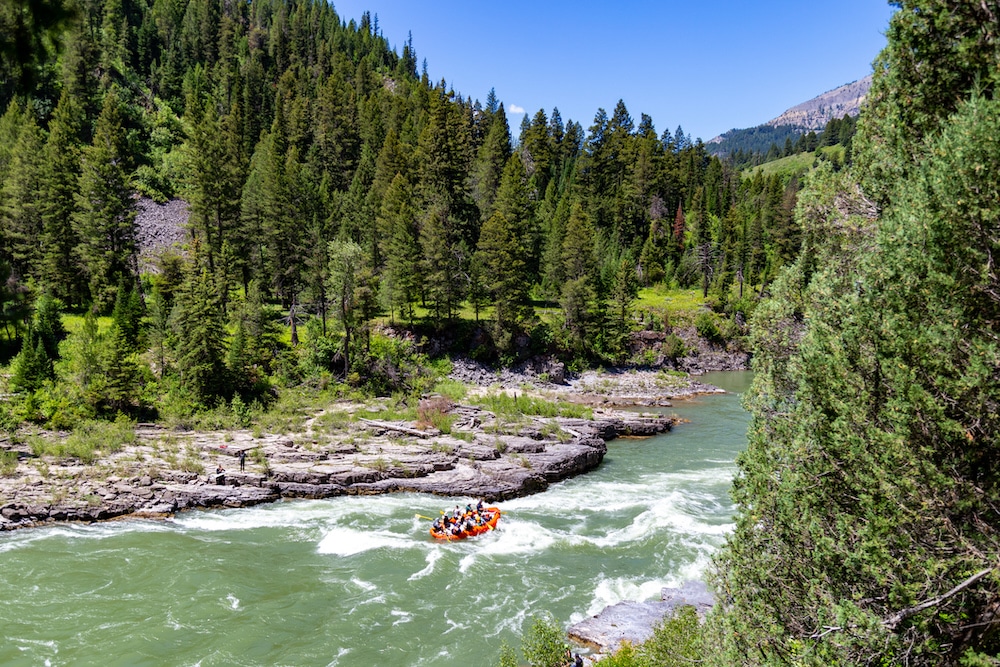
In 1968, the U.S. government passed the Wild and Scenic Rivers Act, designating the first eight free-flowing rivers as protected — the Rio Grande, Rogue, Clearwater, St. Croix, Eleven Point, Idaho’s Salmon and Wolf Rivers.
Today, there are 226 wild and scenic rivers and streams covering more than 13,4000 miles in the national Wild and Scenic Rivers System. In partnership with the public, the U.S. Forest Service works to protect the water quality and free flowing nature of these waterways, as well as safeguard them from development, overuse and other destructive impacts.
Here are some of the country’s most spectacular wild and scenic rivers you might want to explore on your next outdoor adventure.

Designated as a Wild and Scenic River in 2009, the Snake River flows 1,078 miles through the mountains, valleys and grasslands of Washington, Idaho and Wyoming, where it originates. It flows through Yellowstone National Park, as well as the cities of Idaho Falls, Twin Falls, Boise, Jackson and Lewiston, with spectacular views from the Hells Canyon gorge.
“While cruising my motorcycle down through the Hell’s Canyon area of the Snake River on a hot summer day, I literally felt like I was being poured into one of the most memorable and vivid displays of nature’s beauty that I can remember. The canyon walls, steep elevation changes and the winding road itself made for a magnificent and memorable experience, and I remember thinking to myself as I roared down the road, ‘This is exactly why I ride,’” Harley rider and nature enthusiast Patrick Roat told EcoWatch.
The Snake River empties into the Columbia River — which forms the border of Oregon and Washington — and is its largest tributary. While it was once the spawning grounds of over two million wild steelhead and salmon, these species are now threatened or extinct in the Snake River and its tributaries. Their biggest threat are four dams — built in the 1960s and ’70s — upstream of the lower 48 states’ biggest freshwater salmon habitat.
A federal court-ordered review was done by the government in 2016 of whether to keep the outdated dams in place, and the decision was to keep them intact.
“As scientists, tribes, and fishermen all warned, these four dams decimated the Snake River’s salmon and steelhead. The four dams transformed the Lower Snake River into a series of warm, shallow lakes where predators, dam turbines, and hot water kill too many migrating salmon,” Columbia Riverkeeper wrote.
The lives of Snake River steelhead and salmon begin in the mountains of Washington, Oregon and Idaho, before the young fish head to the ocean. They spend several years there before traveling the more than 900 miles to the Salmon River’s headwaters in Idaho. There they spawn at the highest elevations of any steelhead or salmon on Earth.
“The Snake cuts through my hometown of Idaho Falls. I love that river and the falls — once natural but now a source of hydroelectricity. I remember Terry Tempest Williams saying something about how the kind of water we grow up around profoundly affects us, imprints itself upon us. She was talking about the Great Salt Lake, but I was thinking while she was talking about my Snake. I grew up admiring that river but also fearing her, like a wild and strong mother. She mesmerized me and terrified me. On the surface the Snake is so seemingly placid, but she’s also fast. And underneath, there is so much happening because of the rocky river bottom, the pull of the undertows,” writer and teacher Carissa Neff told EcoWatch.
When visiting the Snake River region, you can expect to see plenty of wildlife, including moose, elk, pronghorn, mountain goats, American beavers, North American river otters, marmots and coyotes. Approximately 300 bird species grace the skies of the area around the river, from eagles and osprey to the great gray owl, peregrine falcon, calliope hummingbird and trumpeter swan.
There are a variety of campgrounds along the river, including the Miracle and Banbury Hot Springs, which feature geothermal hot springs, a massage center and kayak rentals.
Juliana Statius Muller rowing a purple whitewater cataraft on the Rogue River. John Jones
At 215 miles long, the lower portion of Oregon’s Rogue River was one of the original Wild and Scenic Rivers Act designations of 1968. The wild and scenic Lower Rogue River runs 84 miles from the Applegate River mouth — about six miles from Grants Pass — to the Lobster Creek Bridge.
The Rogue originates in the Cascades on Mt. Mazama’s western slopes — not far from Crater Lake National Park — before emptying into the Pacific at Gold Beach. The river is famous for its whitewater rafting and salmon and steelhead runs.
A war between white settlers who had come to the region during the Gold Rush and members of the Takelma, Athabaskan and Oregon Shasta Native American Tribes resulted in Tribal members being forced from their land onto reservations in 1856. Their descendants are members of today’s Confederated Tribes of Grand Ronde and Siletz.
In addition to Chinook and coho salmon, green sturgeon, steelhead and cutthroat trout, the Rogue is home to Roosevelt elk, black bears, otters, black-tailed deer, American beaver, ospreys, green herons, great blue herons, red-winged blackbirds, Steller’s jays, woodpeckers, Canada geese, kingfishers and bald eagles.
Among the many hiking options along the river, the 40-mile Rogue River National Recreation Trail will take you along its wild and scenic section from Grave Creek to Big Bend. Along the trail you will have opportunities to encounter spectacular waterfalls, wildlife, wildflowers and historical sites.
Other trails along the Rogue River include the 1.1-mile Redwood Nature Trail loop that begins near Brookings, Oregon; the 9.5-mile Wagner Butte Trail — an out-and-back hike near Ashland; and the moderately difficult 0.8-mile out-and-back National Falls Creek Trail near Prospect, Oregon.
The Wild Rogue Wilderness canyon that surrounds the river gives watershed protection for its wild and scenic portion, which features vertical cliffs with sharp-edged ridges. Here you’ll find striking geological formations, old-growth forests and pristine meadows with wildflowers like redwood sorrel, wild ginger, mock orange and red flowering currant.
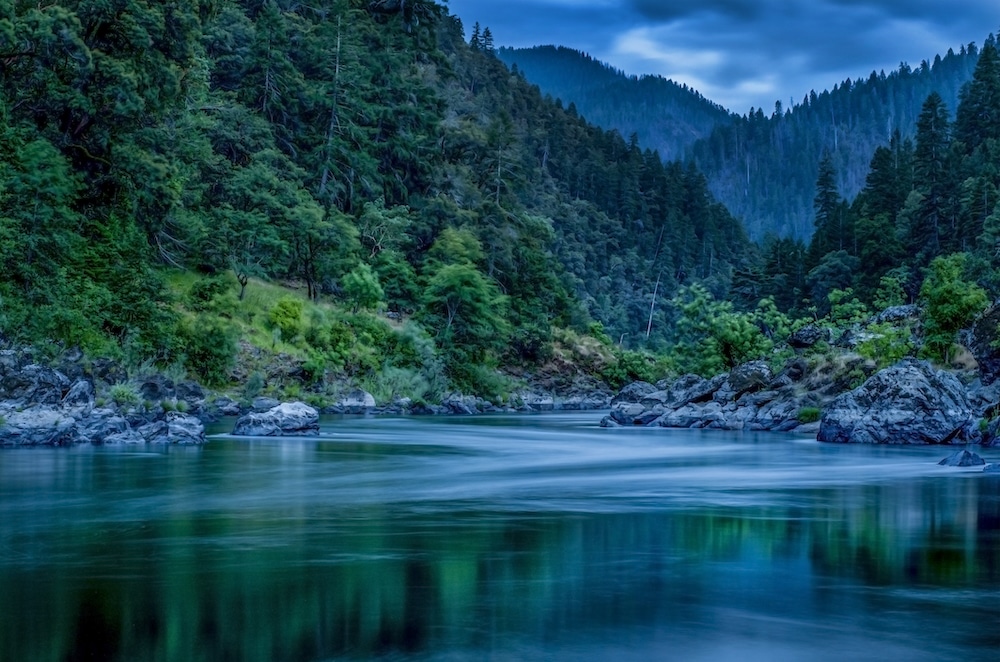
Large cedar, Shasta red fir and white fir trees hug the upper portion of the river, while broadleaf evergreens, a variety of conifers and deciduous trees grow further downstream. The whole Rogue River canyon is populated by enormous Douglas fir, ponderosa pine, Jeffrey pine, oak, manzanita and madrone trees.
Another of the many wonderful things about the wild and scenic section of the Rogue River is that — in addition to many unmarked, established campsites — camping is allowed anywhere along the river that is “physically suitable for your group,” according to the Bureau of Land Management.
“Around the second half of October each year, the Wild and Scenic section of the Rogue River might include some fun Halloween surprises – in the form of cute miniature pumpkins. The pumpkins start appearing on mid-channel rocks on both sides of the river between Alameda campground and Foster Bar. I have yet to see who places the pumpkins, but it is really fun to see a little pumpkin on a rock in the middle of a rapid, right where you need to make a move with your oars,” adventurer Sarah Strock told EcoWatch.
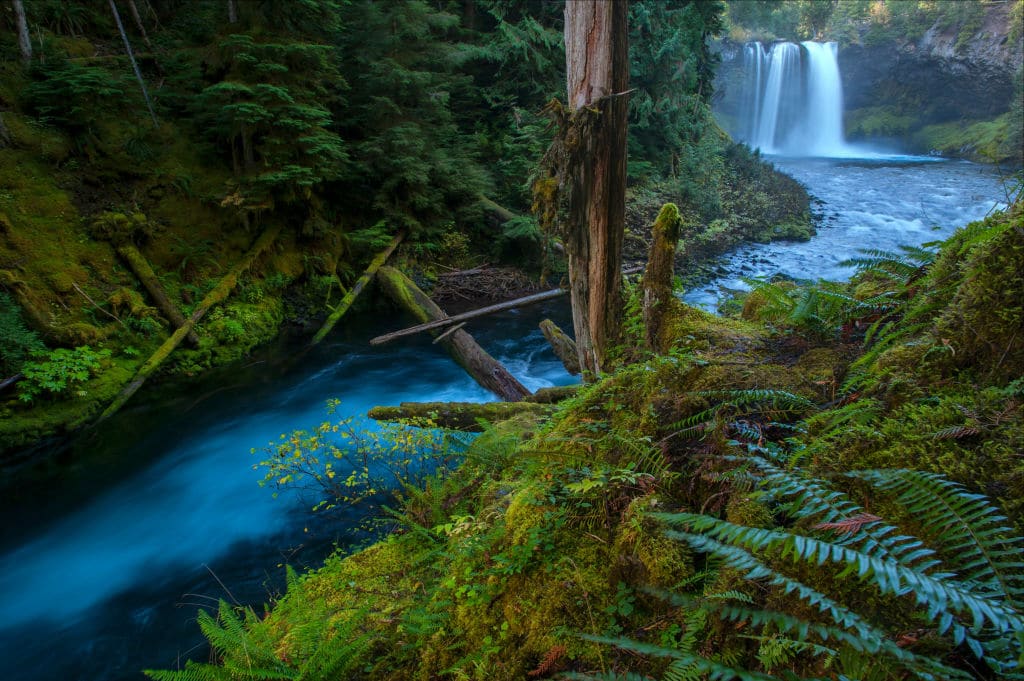
My favorite river in Oregon, the stunning McKenzie River was given wild and scenic status in 1988. It originates in the Central Cascade Mountains at Clear Lake, flowing southwest through Willamette National Forest.
The cool, clear McKenzie runs beneath cedar, pine and maple trees. And on sunny days, the dappled river flows over the millennia of cobbles and hardened lava of the ancient riverbed.
The upper portion of the McKenzie River Basin was shaped by volcanic activity and lava flows that formed waterfalls, pools and whitewater. Clear Lake was carved out by a basaltic lava flow, and lava flows also created the river’s Koosah and Sahalie waterfalls. These aspects of the river provide magnificent views for hiking and kayaking, as well as extraordinary whitewater rafting.
The McKenzie is home to a host of fish species, including wild spring Chinook salmon and native rainbow, cutthroat and bull trout.
The McKenzie River National Recreation Trail offers 26 miles of spectacular “easy” level hiking for all ages and recreational opportunities along the river, including 11 trailheads, campgrounds and views of Tamolitch, Koosah and Sahalie Falls.
Close to the McKenzie River National Recreation Trail is the McKenzie Bridge Campground, which offers 20 campsites tucked beneath western red cedar and Douglas-fir trees, all with river access.
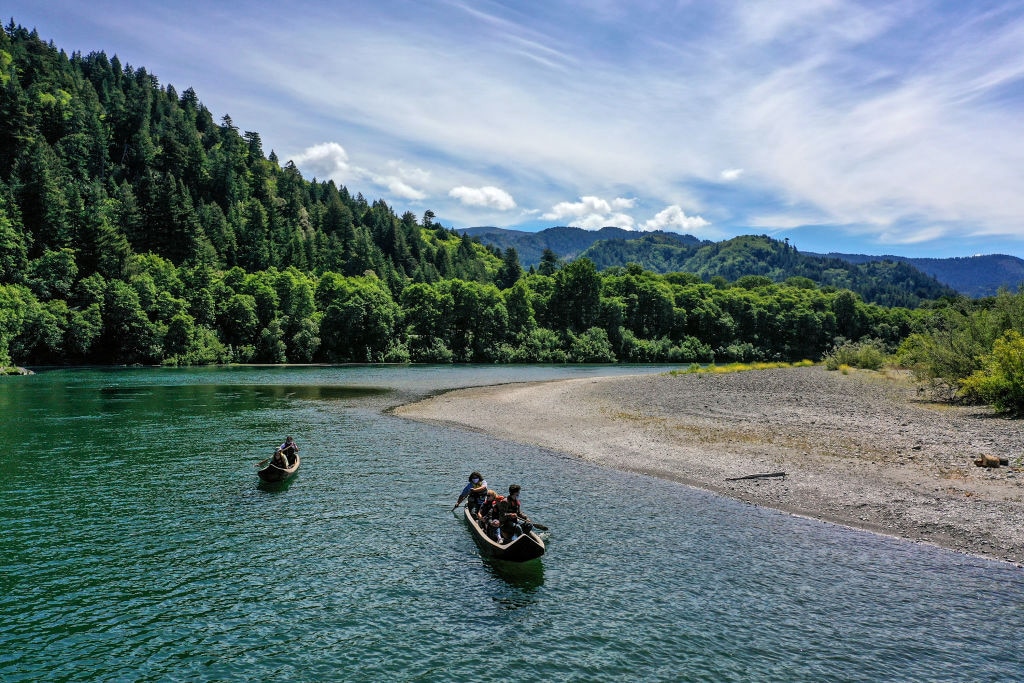
Another magical Western U.S. waterway — added to the National Wild & Scenic Rivers System in 1981 — is the Klamath River. The 257-mile blue-green river originates on a plateau in South-Central Oregon, east of the Cascades. Underground springs swell from cracks in the volcanic rock, feeding the river. Other sources include the Williamson, Sprague, Wood and Sycan rivers, Upper Klamath Lake and the region’s wetlands and marshes.
The Klamath River Basin stretches through parts of six Oregon and California counties and has been the territory of several Native American Tribes — including the Shasta, Hupa, Klamath, Yurok and Karuk — for thousands of years. The river’s once-plentiful salmon were harvested by the Tribes sustainably using weirs.
There are currently dams on the Klamath River that block salmon habitat and create water quality issues, but they are scheduled to be removed, and one has already been taken down. In addition to coho and Chinook salmon, the glittering river supports populations of steelhead trout whose populations have been cut by approximately 95 percent.
“Four dams along the Klamath River, which runs from Oregon into northwestern California, are scheduled to be removed in 2023 and 2024 – Copco No. 1, Copco No. 2, Iron Gate, and JC Boyle. These dams total 400 vertical feet and choke fish passage along hundreds of miles of waterways, making this a historic opportunity and one of the largest dam removal projects to date. And construction has started!” the American Rivers said.
Some of the more than 430 species of wildlife — including 263 types of birds — who call the Klamath River Basin home include elk, antelope, pronghorn, black bears, cougars, mule deer and river otters. The U.S. Fish and Wildlife Service, as well as the states of California and Oregon, have designated dozens of these species “at risk” or “of concern” due to shrinking populations and habitat loss. As the largest freshwater wetlands found west of the Mississippi, the basin is essential for the region’s fish and wildlife.
The Klamath River rushes through several wilderness areas and national forests on its journey west and south, including Klamath National Forest in Oregon and Six Rivers National Forest in California.
This wild and scenic river has hundreds of trail miles to hike — including the nine-mile Klamath River Trail loop and the Pacific Crest Trail, which crosses the river near the town of Seiad Valley, California — as well as five wilderness areas nearby.
The post 4 Must-See Wild & Scenic Rivers in the U.S. appeared first on EcoWatch.
This week’s inspiration is from urban planning expert Fred Kent of the Project for Public…
The post Earth911 Inspiration: If You Plan For Cars And Traffic appeared first on Earth911.
Coastal Georgia regulators want to change a rule designed to protect the state’s marshes, which serve as a buffer against storms and rising sea levels and a vital part of the coastal ecosystem. But advocates say the seemingly small change points to a need for a broader review of marsh protections.
The state passed a law to protect coastal salt marsh half a century ago, which means that now, though Georgia has just 100 miles of coastline, it’s home to half a million acres of salt marsh — the second-largest amount of salt marsh in the country and a third of the marshes on the East Coast. Those marshes absorb the power of strong storm surges and capture carbon in their grasses and mud.
So coastal advocates are especially sensitive to changes in the state’s marsh law — concerned that modifications to allow more development could erode protections, leading to actual erosion of the coastline itself.
But at a public meeting last week on the proposed change, state officials tried to assuage concerns.
“This amendment is not intended to roll back any marsh protections,” said Jill Andrews, chief of coastal management for the state’s Coastal Resources Division, or CRD. “It will not change a thing within the actual Coastal Marshlands Protection Act itself. It is not intended, nor will it, fast-track bulkheads or shoreline hardening.”
Salt marshes exist along much of the country’s coastline, from New England to Florida, along the Gulf, and on the West Coast — but many have been degraded or destroyed by development, industry, and other human activities. Multimillion-dollar efforts are underway in many of those places to restore marsh habitat. In the Southeast, coastal managers have launched a new regional initiative aimed at restoring and better protecting the marshes in the Carolinas, Georgia, and Florida.
In Georgia, most structures built in the state’s well-preserved coastal marshes need a permit under the marsh protection law, also known as CMPA. That goes for large docks, marinas, or a length of bulkhead — a kind of small wall along the waterfront designed to prevent shoreline erosion of someone’s backyard.
Those projects also get a 50-foot buffer, a zone of dry land where no building or paving is allowed because it might affect the marsh. The buffer line is measured from the part of the project that’s farthest from the marsh, known to regulators as the “upland component.” For a marina, that might include buildings for dry dock boat storage, bathrooms, or a shop. For shoreline stabilization like a bulkhead, the upland component might only be underground anchors that hold the structure in place.
The buffer rule is what CRD wants to change, because the agency says it can be a problem for smaller projects.
At the public meeting last week, Andrews explained that the buffer for a bulkhead on a residential property might run through the house. In an example she showed, the buffer encompasses most of a home’s backyard. That means the homeowner couldn’t build a shed, fire pit, or swing set without special permission from the CRD, which the agency says creates a burden both for homeowners and for the agency.
So the agency is proposing a rule change to exempt small projects from the upland component buffer requirement. Andrews and other CRD officials at the meeting stressed that shoreline stabilization projects and anything else built in the marsh will still need CMPA permits, even if the project is exempted from the buffer rule.
But critics said it’s time for a more comprehensive review. Instead of the rule change, several environmental groups are calling for a stakeholder committee to take a holistic look at how projects are approved and what rules protect the marsh.
Speaking at the meeting, Bill Sapp of the Southern Environmental Law Center said bulkheads are particularly worrisome because while building them can stabilize a shoreline in the short term, they can do long-term damage to the marsh. And though each project is small, Sapp said they can add up.
“There are going to be more and more bulkheads built along the Georgia coast over the years as the sea level rises,” he said.
And advocates said this permitting question points to a bigger concern: development too close to the marsh.
Josiah Watts grew up on Sapelo Island and now works for environmental group One Hundred Miles. He told attendees at the meeting the marsh is sacred as well as a protective buffer for the coast, and the state should rethink allowing building close to it.
“When we’re talking about bulkheads, we’re also talking about development,” he said. “That means that there is construction and building near these spaces on the coast and the marsh.”
The Coastal Resources Division is accepting public comments about the proposed change to marsh buffers until January 19.
This story was originally published by Grist with the headline Advocates in Georgia call for better protections for salt marshes, a key carbon sink on Jan 12, 2024.